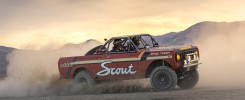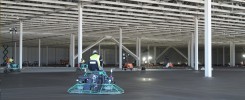WORDS: DREW PERLMUTTER
PHOTOS: CHRIS HUNT
We’re live from the NORRA Mexican 1000.
Scout Motors and Anything Scout’s Vintage Scout Race Program have returned to the Mexican 1000® — a race fueled by grit, legacy, and this year, redemption after last year’s devastating crash. Scout has a history steeped in racing and Baja. It’s been a proving ground for our vehicles and our factory racers since the 1960s. This year, Sean and Owen Barber are racing their rebuilt 1976 Scout Terra.™ For this father and son team, it’s not just a return to Baja, it’s a statement for both them and for Scout Motors: Scouts Always Come Back.
We’re live on the ground in Baja, following Sean and Owen from start to finish. Follow the journey as we share updates throughout the week on Scout Stories and our social channels, capturing dusty miles and even dustier smiles at the “Happiest Race on Earth.”
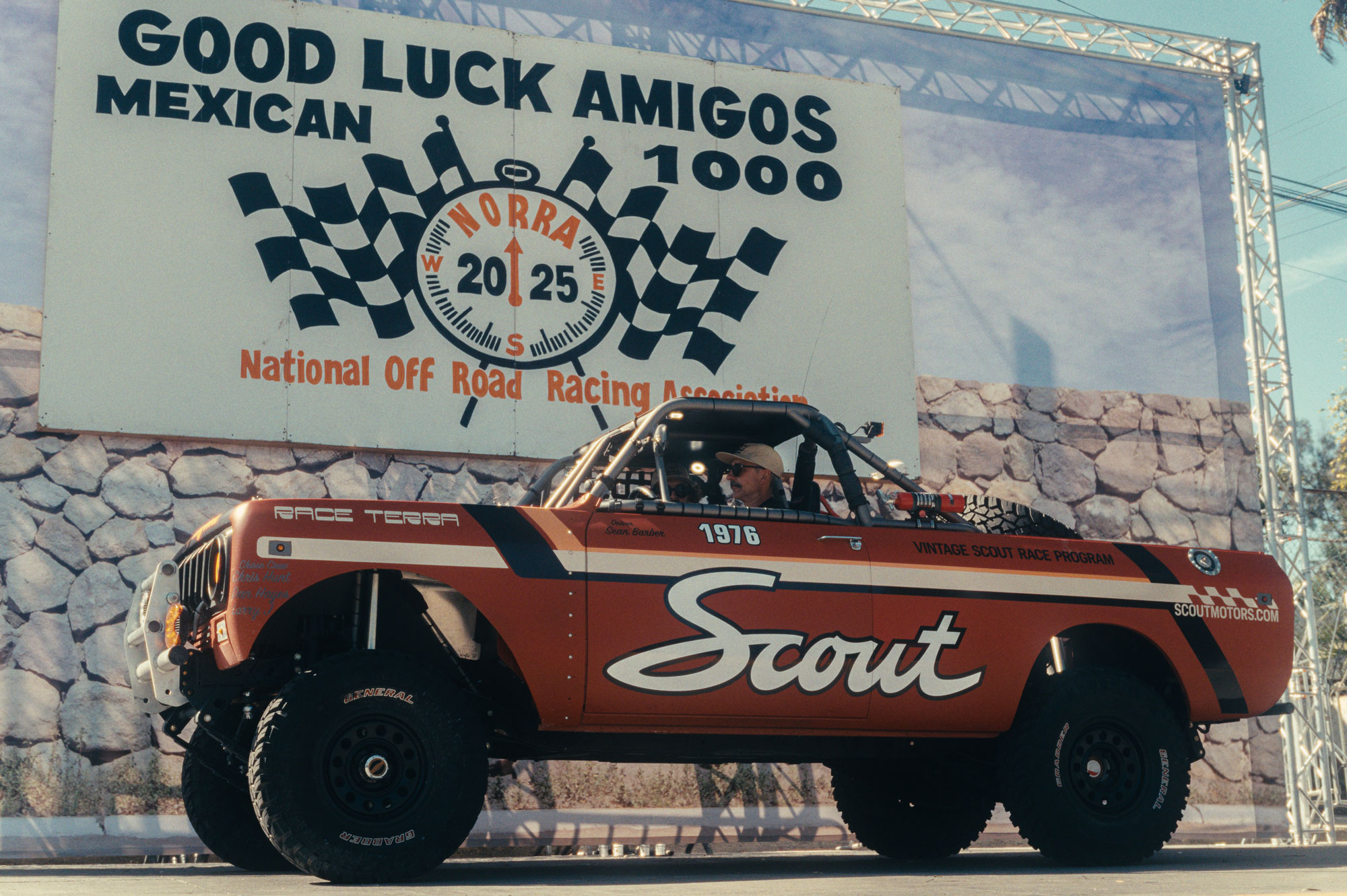
April 24-25, 2025
ENSENADA:
REGISTRATION & TECH INSPECTION
Miles: 0
ack to Baja" is the motto for this trip. The mission statement for Scout Motors and the Vintage Scout Race Program. It’s about reconnecting with our legacy. Scout vehicles were here half a century ago, helping define an era of off-road racing and innovation. And now they’re here again.
We crossed the border into Baja early this morning, with our sights set on Ensenada by early afternoon. The trucks run on gas, but our team was running on coffee and eggs.
Ensenada comes alive during race time. Trophy trucks, vintage Volkswagen Beetles, motorcycles, dune buggies, and side-by-sides fill the streets. Fans line the sidewalks, waving and snapping photos of everything that rolls by.
First step: tech inspection. A vital part of racing. We check everything safety-related—seatbelts, safety harness, roll cage, fire extinguisher. Check, check, check. The lights work, the brakes function, the GPS gets installed. The finishing touch: a time card sticker on our door so officials can track our pace. We pass tech and breathe a sigh of relief. One step closer.
Our Race Terra is fitted with a 196ci motor, punched out .030 over, and an 11:1 compression ratio running on race gas. This engine is literally half of a V8. International Harvester took their 392 V8s and halved them into what’s referred to as a “slant-4.” The Race Terra even features the same pistons from Sherman Balch’s Baja-winning Scout truck from the early 1980s. A little heritage, a little history, and a little good luck to keep us grounded.
The truck glows in the midday sun—the Terracotta color fits perfectly into the landscape of Baja. You can hear the Scout from blocks away as the motor echoes through town.
Even with a passing tech inspection, there’s still a punch list of things to do. Larry and Dan grab a permanent marker and a piece of cardboard. Sean Barber is our leader, our captain. When he speaks, we listen. He starts calling out:
“Need a new taillight bulb. Top off the clutch fluid. And let’s do something about that squeaky belt.”
Dan and Larry get to work. Parts and tools are emptied from the chase and support trucks. With ease, the issues are remedied…mostly.
A shorter belt needs to be sourced from a local auto parts store. But to make room for it, Larry takes a Dremel to the fan shroud to create some clearance. In true race spirit, on the night before the start, last-minute adjustments and fixes are made.
It’s a sight to see—and hear—power tools and grinding coming from under the hood of the Race Terra on the eve of the Mexican 1000.
We soon learn that there are no ½” shorter belts available anywhere in Mexico—only 1” shorter. We source one anyway, just to have it, but stick with the slightly long belt and deal with the noise.
Evening settles in. Daylight fades. There’s not much left to prep. Sean and Owen Barber climb into the Race Terra to rehearse their race-day checklist.
Sean and Owen are father and son. Driver and co-driver. Friends. They’ve got it down. Owen runs through the list. Sean replies “check” to every item.
“Do the brakes feel better?” Owen asks.
“Let’s keep a wrench on the dash to release brake pressure if needed,” Sean replies.
Check.
Tomorrow we race.
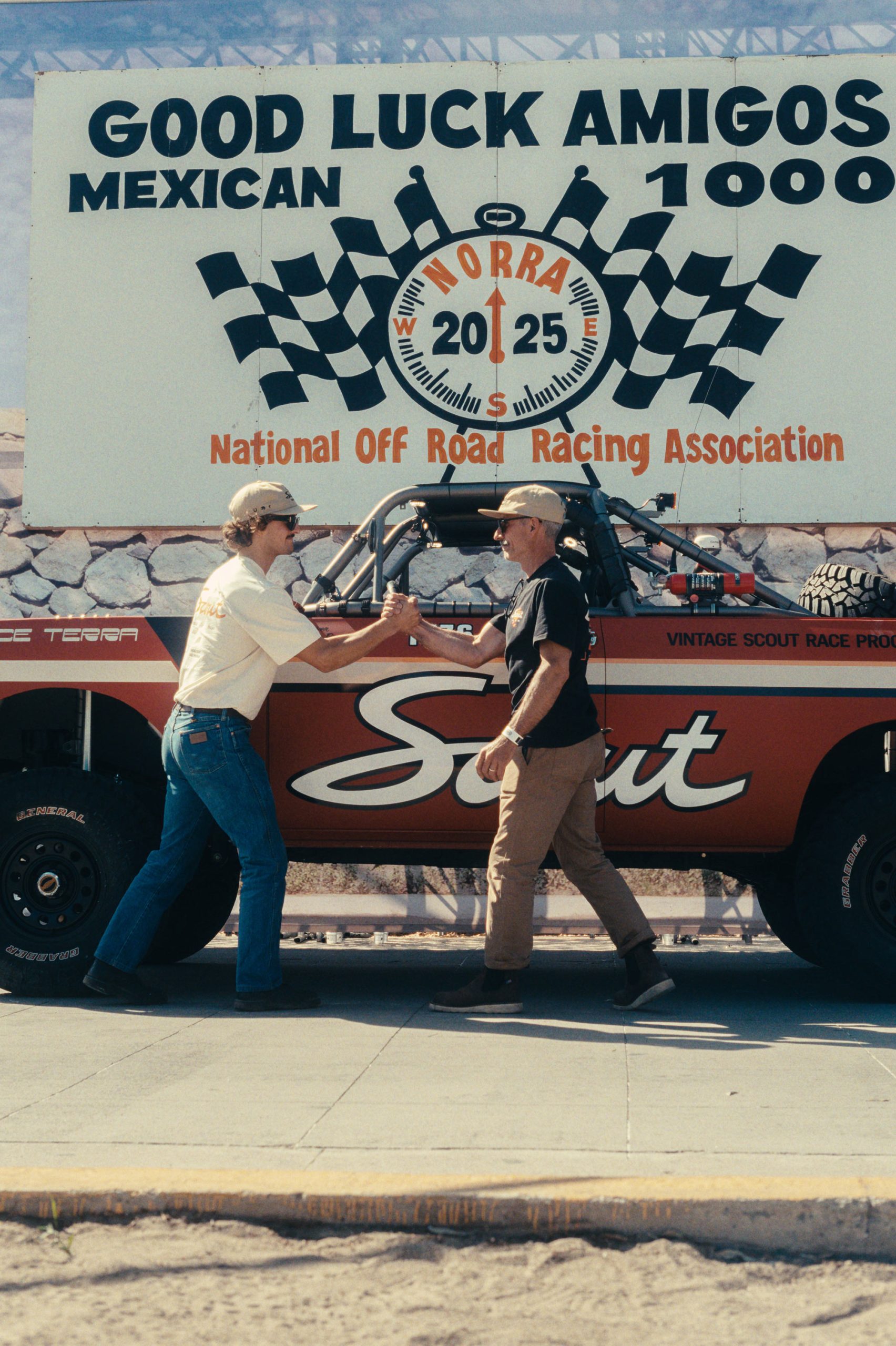

April 26, 2025
STAGE 1:
Ensenada to San Felipe
Miles: 198.1
t 10:34 a.m., the green flag dropped, and we were off. It’s real now, and there is no turning back. A year's worth of resilience and rebuilding, all leading to this moment. “Good luck, amigos.”
The “rally-style” format of the NORRA Mexican 1000 involves point-to-point racing. Over the next six days and 1,400 miles, Sean Barber and his son Owen — along with their 1976 Scout Terra — will traverse the entire Baja Peninsula.
The race begins in Ensenada with a “transit stage,” miles spent on pavement that do not impact their cumulative race time. The first 16 miles take you through town, amongst civilian traffic. It’s a spectacle: race machines contrasted against the local landscape, passing loncherias and farms.
Soon we hit our first “special stage” — off-road race sections that add to their cumulative time. This is where the real fun begins, where the pedal meets the floor and the modest 196ci screams to life.
The Race Terra paints a terracotta line through the desert, glowing from the late-day sun. In a matter of moments, it’s gone, and all that’s visible is a trail of dust disappearing into the desert.
Today’s course varies from high-elevation mountain passes to rugged trails and tight switchbacks. The Race Terra neared 5,000 feet at its highest point today. From there: hard-packed dirt, loose dirt, rocks, and the infamous whoops. Baja’s landscape is quick to test those who dare to face it. The racecourse is scattered with broken-down cars and missing parts. Everything is an obstacle; maximum focus required.
It’s hard not to feel nostalgic. The 1976 Scout Terra breathes its legacy into the trail it leaves behind. A few times throughout the day, the Scout reappears on pavement for more “transit stages” through the small towns scattered along the peninsula. Each is a makeshift checkpoint in the middle of nowhere. Spectators gather at the intersection of pavement and dirt to see the sight.
The sound of the breeze is soon interrupted by the roar of the Race Terra. It appears suddenly from behind the desert brush and cactus. Officials mark the time card, and Sean and Owen meet up with the chase crew.
“It looks like you’re losing oil,” shouts Dan over the motor. Sean cuts it off.
“Four-wheel drive is making a noise,” he responds.
The chase crew surrounds the truck from every angle, visually inspecting every inch. Leaks are searched for, bolts are checked for tightness. Sean and Owen hop out for snacks, a leg stretch, and a report about the day so far.
“Other than that, she’s doing good. Engine is running good, we’re feeling good.” Sean drives; Owen navigates. They have it down to a science. Owen starts shouting out numbers.
“Okay, we got here seven minutes ago, we’ve got 12 miles ahead of us, and 20 minutes left for this transit.”
All that means is we have a few more minutes to snack and drink before continuing on. When in a transit stage, you can be penalized for being too early or too late to the next checkpoint.
The crew continues looking over the truck. Larry checks the oil. Dan is underneath, rotating the driveshaft to see if anything obvious is wrong with the four-wheel drive.
“We’ll only use it when we need it,” Sean calmly states.
Dan can’t find any obvious issues, and right now the terrain doesn’t demand all four wheels. Owen grabs some spare gas from the chase truck and tops off the Race Terra.
It’s a brand-new engine this year; fuel economy and range are still unknown, but after today, we’ll have a better idea. Sean recreates the noise he hears one last time for Dan.
“Brrr, brrr, brrr. When the shocks cycle up, I’m hearing it.”
Dan says he’ll check the u-joints — maybe the spider gears in the differential — tonight at camp, along with a list of other things.
The sun lowers in the sky, now at our backs as we head from San Matias toward San Felipe to finish our day. The second half of the day builds in excitement. We hit a rhythm in the flow of the waves of sand, getting lost in the mirages on the horizon. The Race Terra is at home in Baja. The humble four-cylinder motor and archaic suspension were made for trucking through the unforgiving.
With the drop of a checkered flag, the boys pull into San Felipe. The sunset reflects off their smiles, ear to ear. A great first day in the desert.
But now, off to camp for nightly maintenance.
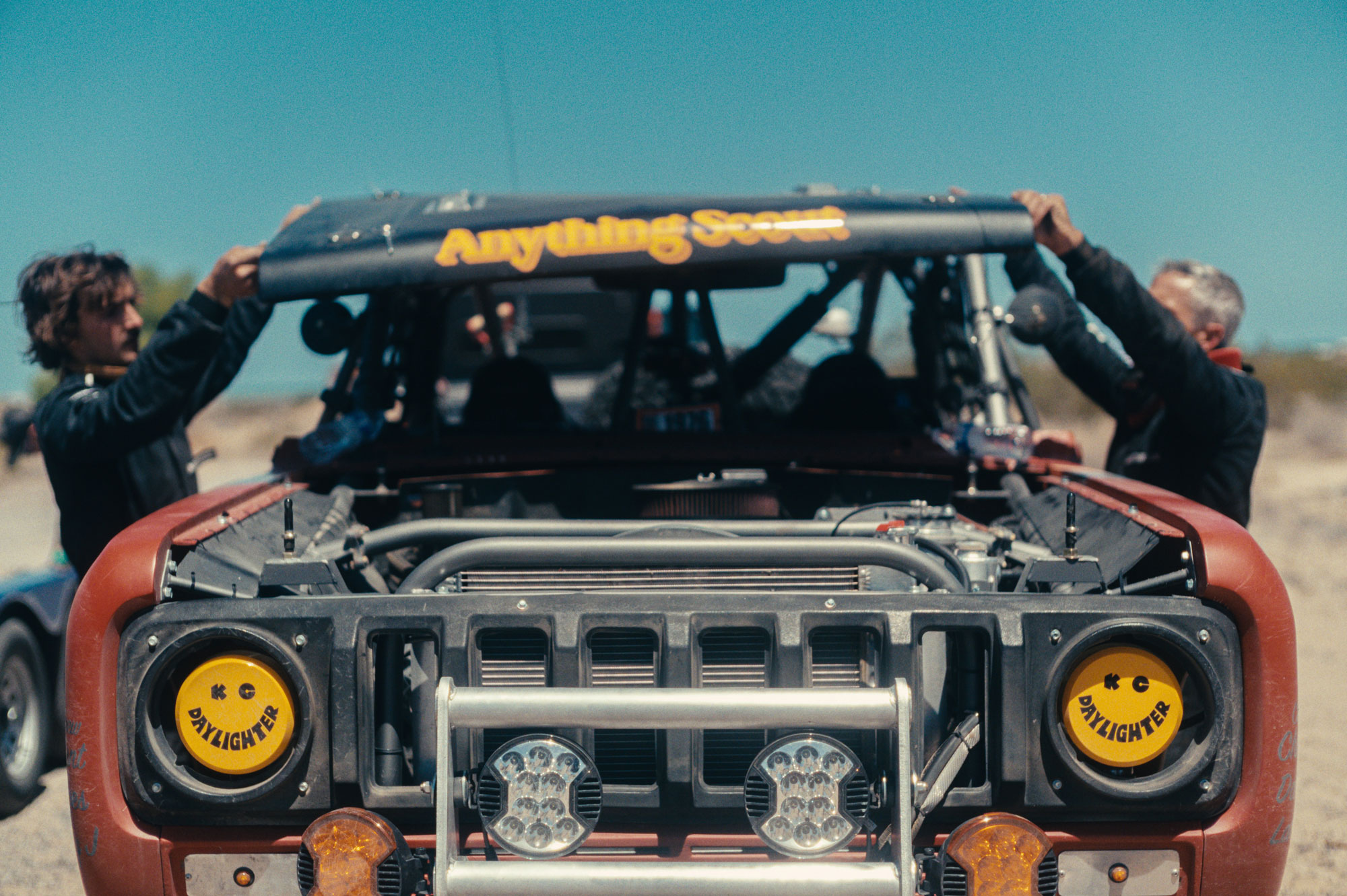

April 27, 2025
STAGE 2:
San Felipe to Bahía de los Ángeles
Miles: 254.7
acing is a team sport — driver, co-driver, and crew. The driver drives. The co-driver navigates. The crew does everything else, by any means necessary. If you’re part of the vintage International Harvester® world, you probably know Dan Hayes and his parts business, Binder Boneyard. You’ve probably bought something from him too — he’s got it all. Dan, proud of the too-many International Harvesters parked in his front yard, is our crew chief.
Beside him sits Larrance McGee — Larry. Up at the New Legend shop in Iowa, Larry is humble, deliberate, and a sheet metal expert. The sheet metal expert. At just 26, he knows the insides of a Scout door panel better than anyone alive.
These two are the glue holding us together.
Last night, Dan and Larry were up until 12:30 a.m., swapping a differential while Sean and Owen slept. After concerns about a four-wheel-drive noise — and finding glitter in the diff fluid — we knew we’d need the fix before today’s rough stages. Camp the first night had infrastructure; tonight’s wouldn’t. Better to be ready.
Dan finally crawled into his tent. Larry cowboy-camped under the stars on the trailer.
Hours later, the sun cracked the horizon over the Sea of Cortez. Terracotta desert, turquoise water, and a warm, inspiring light. Sean stretched and commented his neck was finally feeling better. Fighting a truck through hundreds of miles of sand is a unique kind of workout.
It’s Day 2, and Sean is already planning Day 3.
“It’s not slow and steady,” he says. “It’s medium and steady.”
Today’s a long one: nearly 250 miles. We drop a few pounds of air from the tires — 22 PSI up front, 20 in the rear — for better traction. Canyons to carve, rocks to crawl, some wide-open sections ahead.
At 10:35 a.m., the green flag waves. We’re off, south of San Felipe, straight into a special stage. Immediate racing.
A bridge spans a dry riverbed — traffic and tourists overhead; Race Terra roaring underneath. Spectators crowd above and alongside, cheering as we vanish into the desert.
Most trucks out here run big V8s. We stuck with a small, original four-cylinder. It’s a unique choice — and it sounds incredible, screaming through the sand.
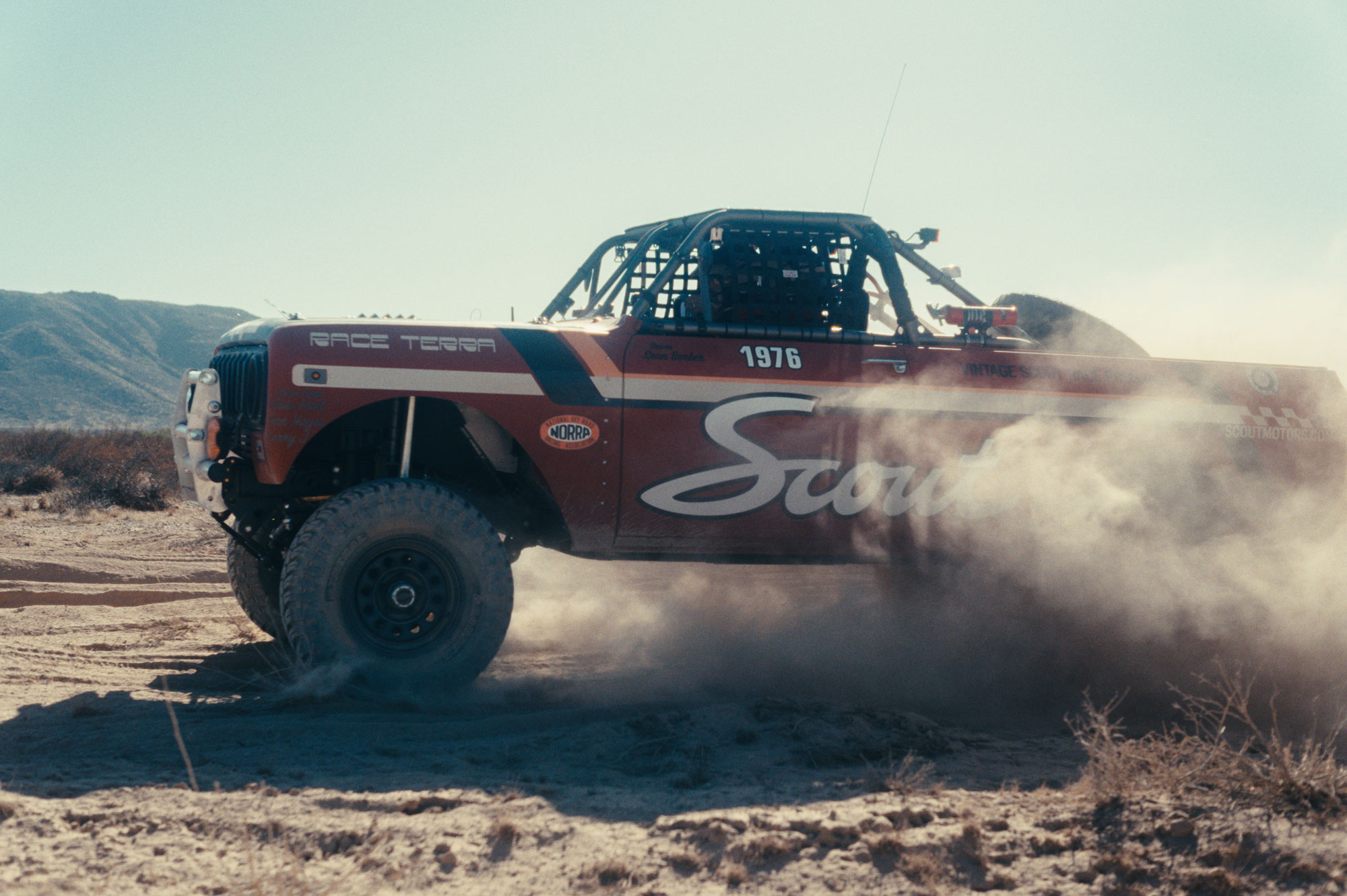

The first time Sean and Owen meet the crew today, it’s quick: hop out, snacks, stretch, status check. Dan and Larry dive straight into the dirt, checklist in hand.
“It’s a whoop-fest, man,” Sean laughs, pulling off his helmet.
“Clearly!” yells Dan from under the truck.
The rear differential is leaking again — bottoming out so hard the fuel cell is striking the diff bolt, tearing threads and causing play. We’d already tried grinding for clearance. Not enough, apparently.
“It’s like delicate surgery,” Dan says, screwdriver in hand, pulling the bolt.
He pulls out orange earplugs — those kinds of earplugs — seals the fix with a heavy coat of RTV and Gorilla tape. In racing, you do what you have to.
Sean thinks fast. “Let’s double up the bump stops.”
Owen calls out times. Another crucial job of the co-driver: clock management. “We gotta leave by 1:25. 1:30 latest.”
Larry grabs the bump stops box. Owen jacks up the truck. They get it done.
Sean mentions the four-wheel-drive noise again — not totally fixed. Noted for later. You prepare for everything… and still expect surprises.
Sean shakes his head, thinking back to the last section. “Forty miles of soft sand. We were at 3,600 RPM in second gear for like an hour straight.”
By the time the Race Terra takes to the course, motorcycles, trophy trucks, and a slew of other vehicles have left their mark, tearing up whatever was. By the time our class makes it through the course, we’d argue the terrain was even tougher.
“But it’s running good, better than ever,” Sean finishes. Last night he dropped in a new carburetor jet, going up one size to richen up the mixture. The truck is responding better now, probably getting seven miles to the gallon.
Larry quickly uncouples the front drive shaft and packs on as much grease as possible. It’s a last-ditch effort to try and remedy the four-wheel-drive noise. The wind blows some sand and rocks in for good luck as we button it back up.
Even the livery looks fast. And it looks so good covered in dust. The 33” tires splash through the sand and over whoops, the late afternoon sun is to our backs as we race down towards Laguna Chapala. This dry lake is another incredibly iconic part of Baja. Back in the early days of desert racing, when some of the first Scouts were down here, Laguna Chapala served as a common pitstop for crews. But instead of chase trucks, they had Cessnas. The terrain was worse, support vehicles were less capable, and flying made the most sense. Fuel drops, parts drops, and a great view, too. The dry lake provided ample room for service. But also allowed racers to open things up. Some cars and trucks will easily see triple-digit speeds here. But again, our motto is “medium and steady.” The Race Terra is soon a mirage.
“Dry as a bone back there!” Dan yells the next time he sees the truck. He’s underneath the rear checking for any differential leaks. All clear. “The four-wheel drive is better, too, but not perfect,” Sean responds. And then they’re off again.
South of Laguna Chapala is the Valle de los Cirios, the largest protected nature preserve area in Mexico. Out of nowhere, thousands of towering cirio plants and giant saguaros fill the desert void. They’re like weeds out here, as far as the eye can see. Tall, ancient, foreign.
The Race Terra sends a GPS message to the chase crew asking for five gallons of gas. Facts are more important than excuses; the chase crew responds that they have none, but will try and source some. Again, an entirely new truck this year, and we’re still learning fuel range two days into the race.
Memories from years past remind us of a roadside “gas stop” further ahead. A local in an old truck with a couple of 55-gallon drums, a siphon, and a hand-painted sign that reads ”GASOLINA” magically appears.
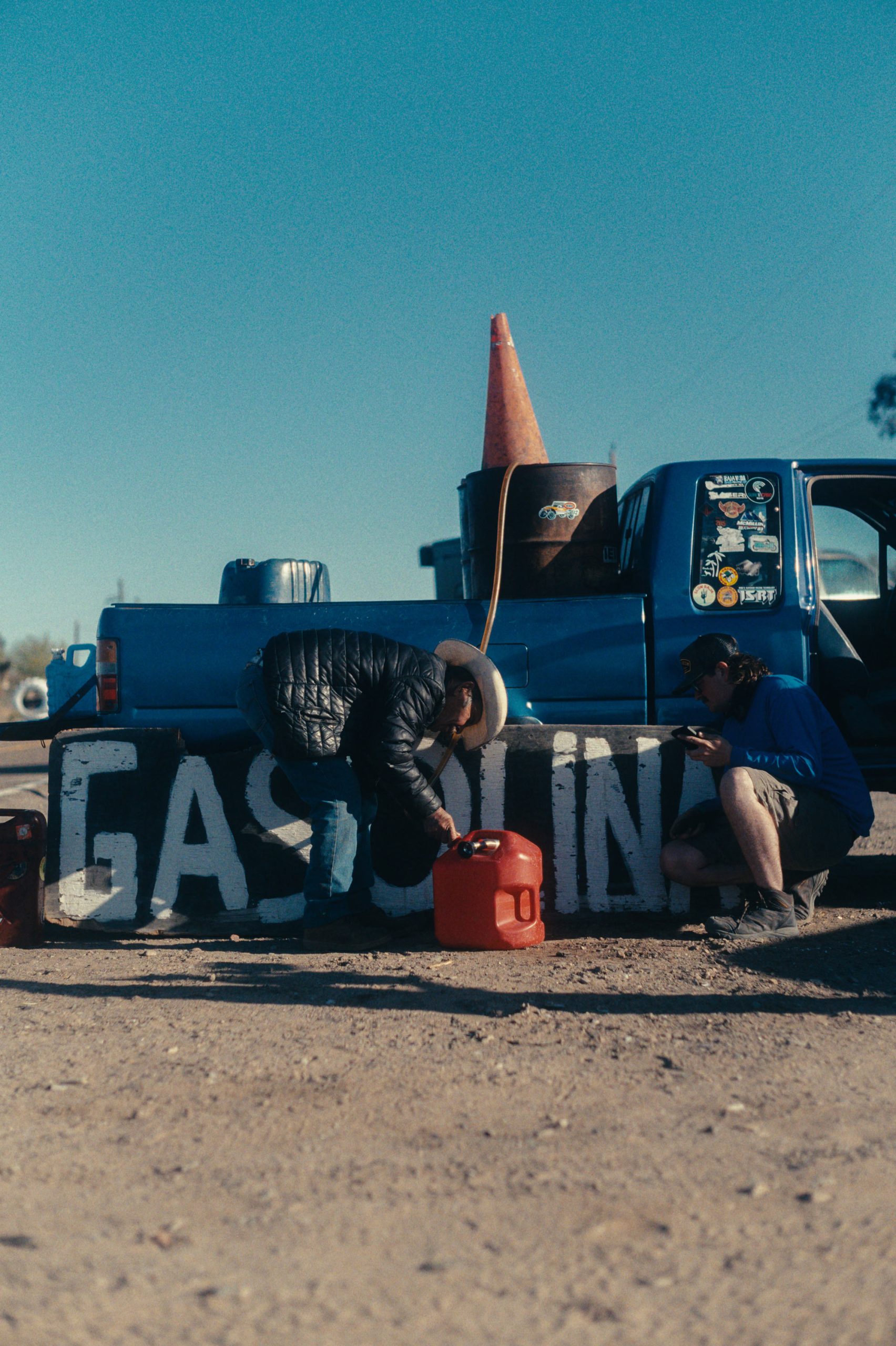

“Lleno, por favor! Fill ‘er up, please!” We never know the quality or octane of gas we’re getting with a stop like this, but it’s necessary at this point. Dan mixes in race fuel concentrate to raise the quality as much as we can. The gas cans get transferred to the four-wheel drive chase truck and readied for a gas deployment.
It quickly turns back the way it came and finds a dirt road that leads towards the course. The crew gets out on foot and sprints forward, arms full of 10 gallons of gas. We catch the Race Terra by 60 seconds, flagging it down and filling it up. It was perfectly synchronized, like we had done it a million times. “That was the most adrenaline I’ve felt in a long time,” says Larry, half out of breath.
From here, it’s the last stretch into Bahia de Los Angeles. The sun is low, and the mountains over the coast into the bay are painted purple. The Race Terra pulls to the finish just at dark, the KC Daylighters illuminated, grinning from ear to ear, just like the drivers. The relief of pulling in for the day is hard to beat; all the past worries from the day melt away for a little while.
Stickers are like currency here. Locals crowd the finish line, kids and fans alike come up to the racers, shake hands, and take pictures posed against the trucks.
Over dinner, we discuss our maintenance for the night. “Everything,” Sean says. “We hit a big rock pretty hard”. Sean asks Larry to grab cardboard and a permanent marker. “I’m a little scatterbrained, let’s make a list,” he says with a mouth full of dinner.
Dan and Larry get busy inspecting the truck. It’s second nature at this point. Sean puts on his mechanic suit for the first time on the trip. He crawls under the truck and starts working. The list is long for tonight.
From beneath the drive shaft, we hear Sean report, “We have to push hard tomorrow. No room for error.”
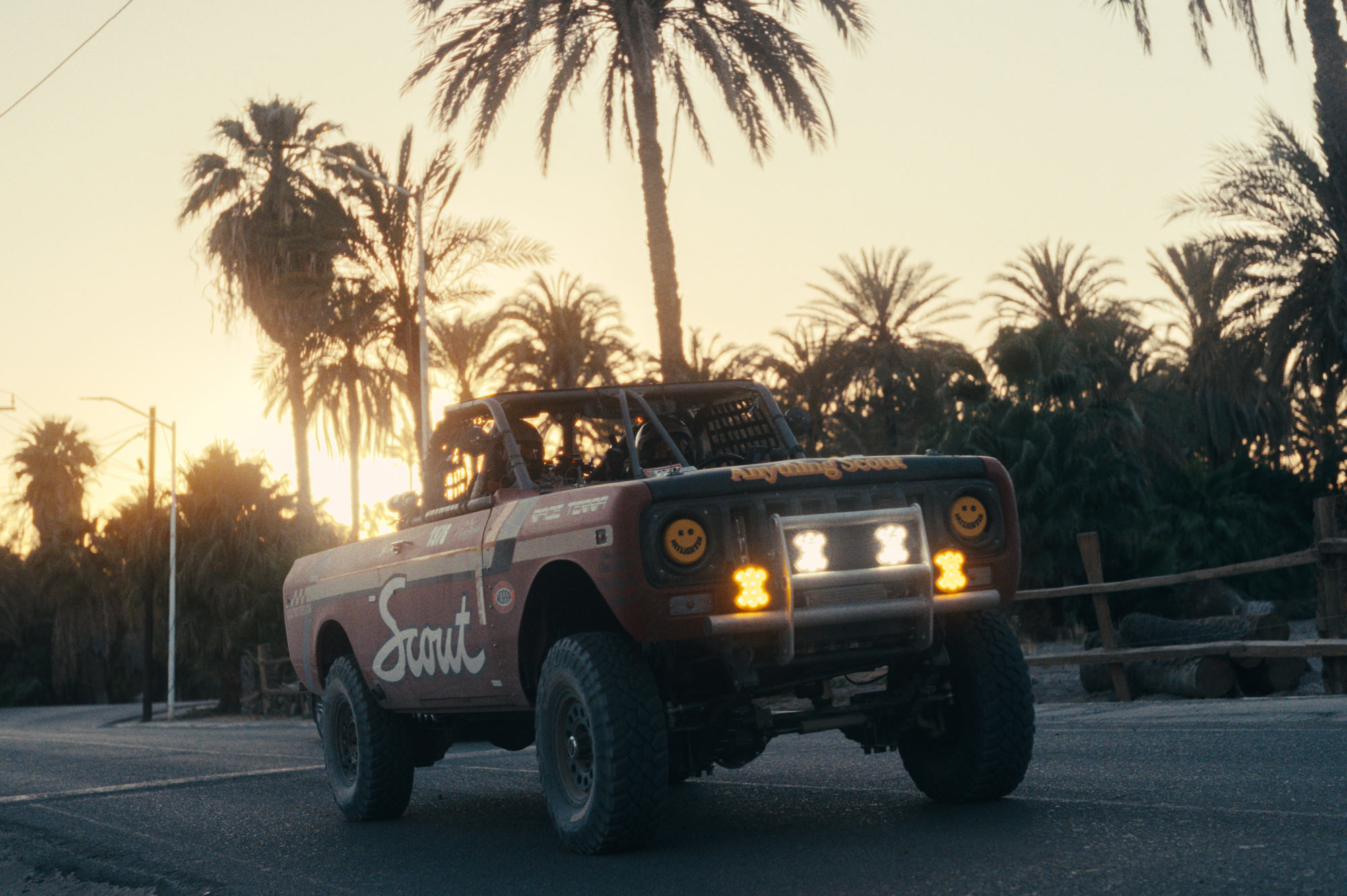

April 28, 2025
STAGE 3:
Bahía de los Ángeles to San Ignacio
Miles: 212.8
ur chase trucks are packed full of nearly every spare part you could imagine. If something on the Race Terra breaks and it’s fixable, we have the parts and tools ready. Also included in our toolkit is coffee. Good coffee. Whole beans that we grind by hand every morning. We have a Jetboil and two pour-overs. We take our coffee as seriously as we take our racing. Both are methodical and calculated. Both get our adrenaline pumping. As the sun rises over our camp in Bahía de los Ángeles, the smell of coffee fills the air.
The team gathers around the fresh brew, as we do every morning. Sean chimes in with some thoughts about the previous day. “We were pushing it hard, man—faster than what I was comfortable with.” Stages close at certain times, so occasionally there’s a race against the clock. “The sun was low, the light was deceiving. We hit a big rock. Real big.” Later in the day, it’s hard to tell the difference between shadows and hazards.
The big rock did some damage. It first made contact with the driver-side U-bolt plate at the front end, left a sizable dent in the oil pan, and cracked the transmission bell housing. There’s not much they can do about any of that for now—until something else happens. Dan says to run it as is.
The first two days of racing were tough, no denying that. Our repairs from last night carry into the morning, but now we have coffee working in our favor. Still chasing a four-wheel-drive noise, we remove the metal collar beneath the rear driveshaft, suspecting a clearance issue between the two. Engaging four-wheel drive adds extra torsion and play, causing the yoke on the rear driveshaft to knock into that part.
“We’re losing some coolant too,” Sean continues, running through all the things he can think of. “Grab some coolant if you pass an auto parts store,” he says, this time directed at Dan and Larry. Then to Owen: “Make sure you keep an eye on the temperature.” The Race Terra usually runs around 180 degrees; if it gets above 200, we get concerned. Dan reminds Sean and Owen, “You have plenty of water on the truck. Just keep her cool.”


Cool. Sean and Owen Barber are cool. They’re Steve McQueen and Paul Newman. There’s a swarm of cameras around them too, which only adds to the attraction. What we’re doing here is iconic. It’s picturesque. Documenting a race crew is an adventure in itself. Think back to all the legendary imagery from desert racing decades ago—all the photos that filled old magazines, the posters that hang in our shops and inspire what we do today. Who took those? Who were the documentary crews responsible for those iconic moments?
We have Chris Hunt, Eric Reding, Ben VanHorn, and Chris Stahl. Chris Hunt sports a Leica SL3 and a 50mm Noctilux. This is his third year in a row supporting the Vintage Scout Race Program on the NORRA 1000—a vital addition to the mix. His previous experiences in Baja aid with navigation and logistics. He’s the one who found the dirt road for us to make yesterday’s gas drop along the course.
Ben carries a Bolex H16 with 500 feet of 16mm film, and also a Leica M6 with a 50mm Summicron. Eric packs a full Sony FX3 kit, with audio for recording onboard driver communications—even a 600mm lens to catch the Scout from miles away. They’re experienced with all things production and media at New Legend and Anything Scout, but it’s their first time down in the Baja desert. Chris Stahl runs Scout Studios, Scout Motors internal content team and is a complete sniper with motion and stills. There’s no terrain he won’t traverse to get the shot.
Between the four of them, their goal is to capture and tell the epic story of this year’s Vintage Scout Race Program on the NORRA Mexican 1000. These will be the photos that hang in your garage one day.
The morning repairs wrap up as other racers and teams walk the pits surrounding the starting line. Those who race Baja are part of an elite few. There’s an unwritten rule down here—we’re racing against each other, but we’re all in this together. Over coffee, we talk about yesterday’s course, laugh about mishaps, and share insights for the coming day. Sometimes, it’s even asking for spare parts.
11:22 a.m. The green flag drops and the Race Terra takes flight down the coast. Today is another long one—212.8 miles. We have two special stages on the course. One nearing 140 miles, the other pushing 70. The only thing that separates the two sections is less than five miles of pavement. The chase crew won’t see the Race Terra for nearly the entire day. There’s just one opportunity for us to meet.
We start in Bahía de los Ángeles, the “Bay of LA.” While the Scout barrels down the east side of the peninsula along the Sea of Cortez, the chase crew heads back west to the opposite coast. There’s only one way in and one way out of the Bay of LA—paved, that is. Though it feels like a trail of its own, dodging chunks of asphalt and deep ruts. There’s a saying in Baja: “Watch out for the potholes—you can’t miss them. Literally.” There’s no avoiding them.
The next time we see the Race Terra, it roars into Villa Alberto Andrés Alvarado Arámburo. Baja is divided into two states, north and south. Earlier in the day, we crossed into Baja California Sur to catch the truck.
“It’s running great, man. Feels so good,” Sean says proudly. He continues, “So fun—we hit top speeds, a lot of wide-open racing. Hey, check the radiator,” now directed at Dan—but he already is. “You’re seeping a little and your overflow is empty.” Owen responds that temperatures stayed cool, so the leak is manageable—for now. Dan grabs a jug of water and starts filling the radiator. Then ten gallons of race gas goes in the tank.
“Dry as a bone!” Dan yells from beneath the rear end, making sure his earplug fix in the rear diff is still holding strong.
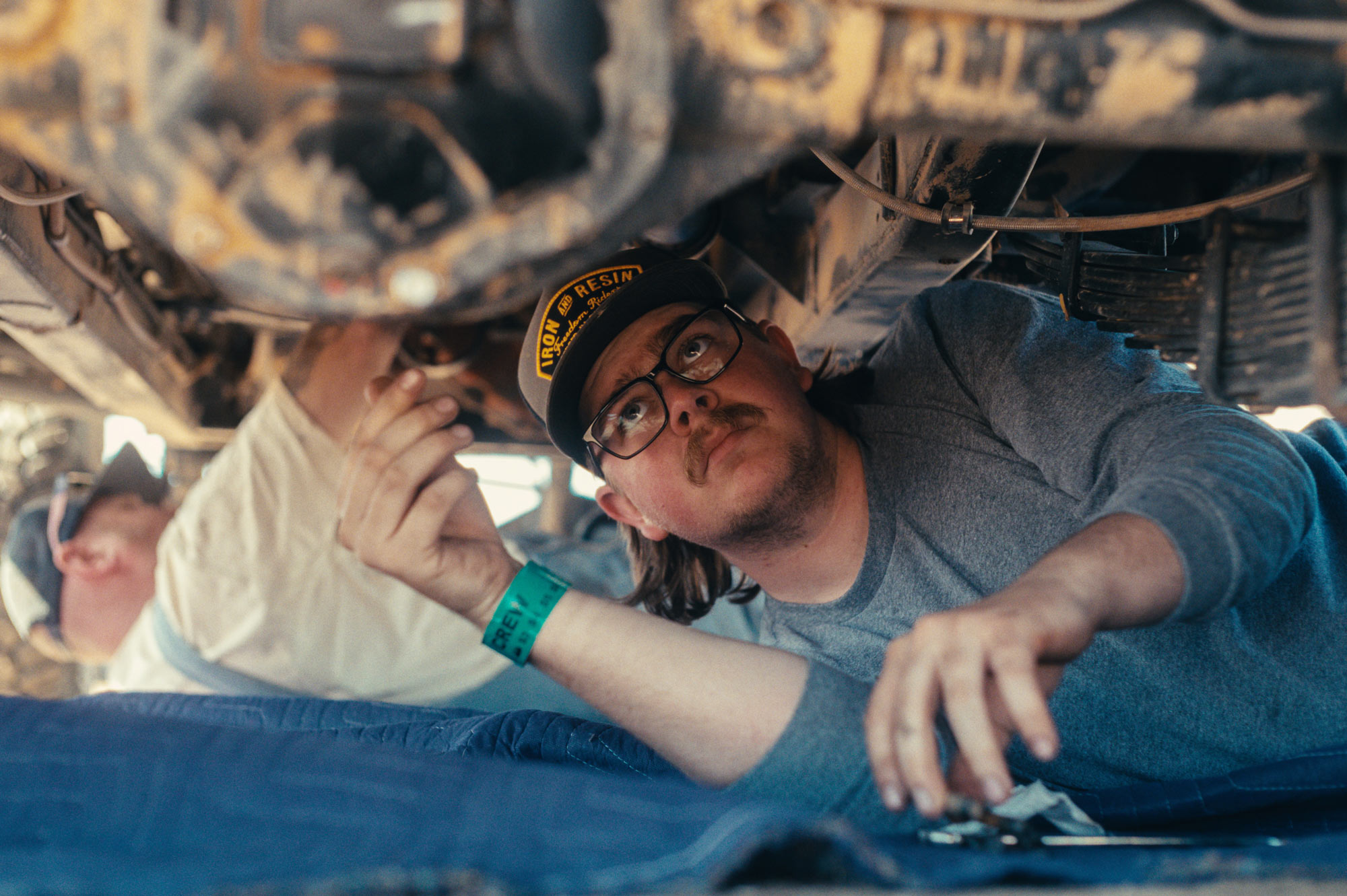

Just as the mechanics have a routine, so does the media team. Cameras out, questions asked, repairs documented. The Race Terra is parked between a banco and a supermercado. The locals have a routine too. Kids flock around the truck and ask for stickers. Employees of nearby businesses step out to take photos and ask if we need help.
Sean and Owen are elbow-deep in beef jerky and trail mix. That—and coffee—is the fuel that powers them through the day. Soon, the roar of other race cars fills the streets. A Porsche flies by, followed by a Class 11 vintage Baja Bug just now catching up to us. Both started the day well before we did—but that’s Baja. Anything can happen. The desert doesn’t discriminate.
“So good,” says Sean, still thinking about the last section of racing. Owen chimes in, “Today we’re ripping,” mouth full of raisins and chocolate. Today’s stoke almost makes up for the previous days’ trials and tribulations. There’s nothing that says the first couple days are supposed to be easy. Helmets are back on—now off to San Ignacio.
Sean’s wish from the previous night—to push hard today and have no room for error—came true. The sun is still bright in the sky, golden hour just beginning as the boys pull into the historic town square. San Ignacio is a true oasis in the desert. Thousands and thousands of palm trees instantly appear out of the thin desert air. There’s a river that runs through—it’s the most green we’ve seen all trip. A long and winding road leads to the top of town, where the San Ignacio Mission towers over the flora. Built in 1728, the mission and surrounding architecture feel frozen in time. It’s a sleepy town that comes alive during race week.
Sean and Owen exit the truck and kids immediately surround them yelling, “Stickers! Stickers!” Right on cue, Dan and Larry bury themselves beneath the truck.
“Looks good, no leaks,” Dan reports.
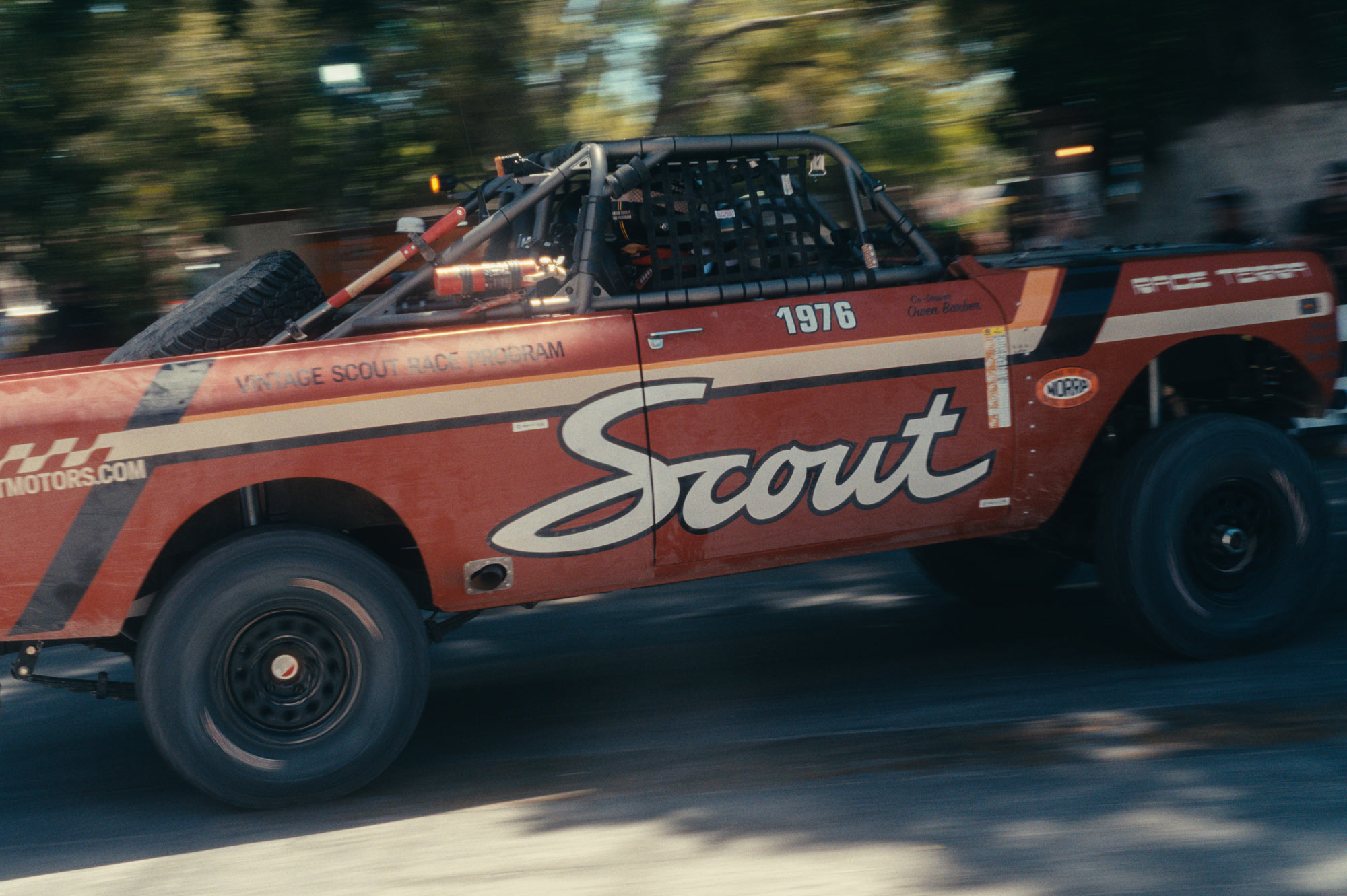

April 29, 2025
STAGE 4:
San Ignacio to Loreto
Miles: 214.9
orning doves and woodpeckers are our alarm clocks. We wake up to cold tents and visible breath. It’s about 7°C—45°F. A chilly start in the desert. Furnace by day, freezer by night. Dry air doesn’t hold heat well. San Ignacio is a true high desert oasis—spring-fed and palm tree-filled, keeping it cool and green year-round.
“Keeping it cool.” Another good mission statement for the trip. A new radiator went in last night to help with that. Over the past three days, the Race Terra has laid down over 650 miles across the peninsula. Breaking and shaking things loose is part of the game. But we’re ready for it all.
Today’s goal: 214.9 miles. The Race Terra barrels down the Pacific Coast while the chase crew hugs the eastern coast. We’re separated by the Sierra de la Giganta—the “Range of the Giant.” If something goes wrong, there’s no way for us to reach them in our support trucks.
It’s a hard fact to ignore—but there’s nothing we can do about it. Memories from last year idle quietly in the backs of our minds. Sean and Owen suit up like it’s any other day.
11:13 AM – Green flag. The Race Terra blasts through the historic town square of San Ignacio, one last time, then disappears into the desert once again.
We’re the only Scout competing in the race this year—and proud of it. People are surprised to see it here. Among a sea of vintage Chevys, Fords, and Jeeps, our truck stands out. For the past three years at the NORRA 1000, the Vintage Scout Race Program has had backing from Scout Motors. They’re one of the only factory manufacturers supporting a vintage race team.
For Scout Motors, it’s the perfect opportunity to showcase someone who embodies the spirit and heritage of the Scout namesake. There’s no one quite like Sean Barber. He’s responsible for keeping so many old trucks on the road. Anything Scout is known for its drivability conversions. New Legend is known for its bespoke Scout builds.
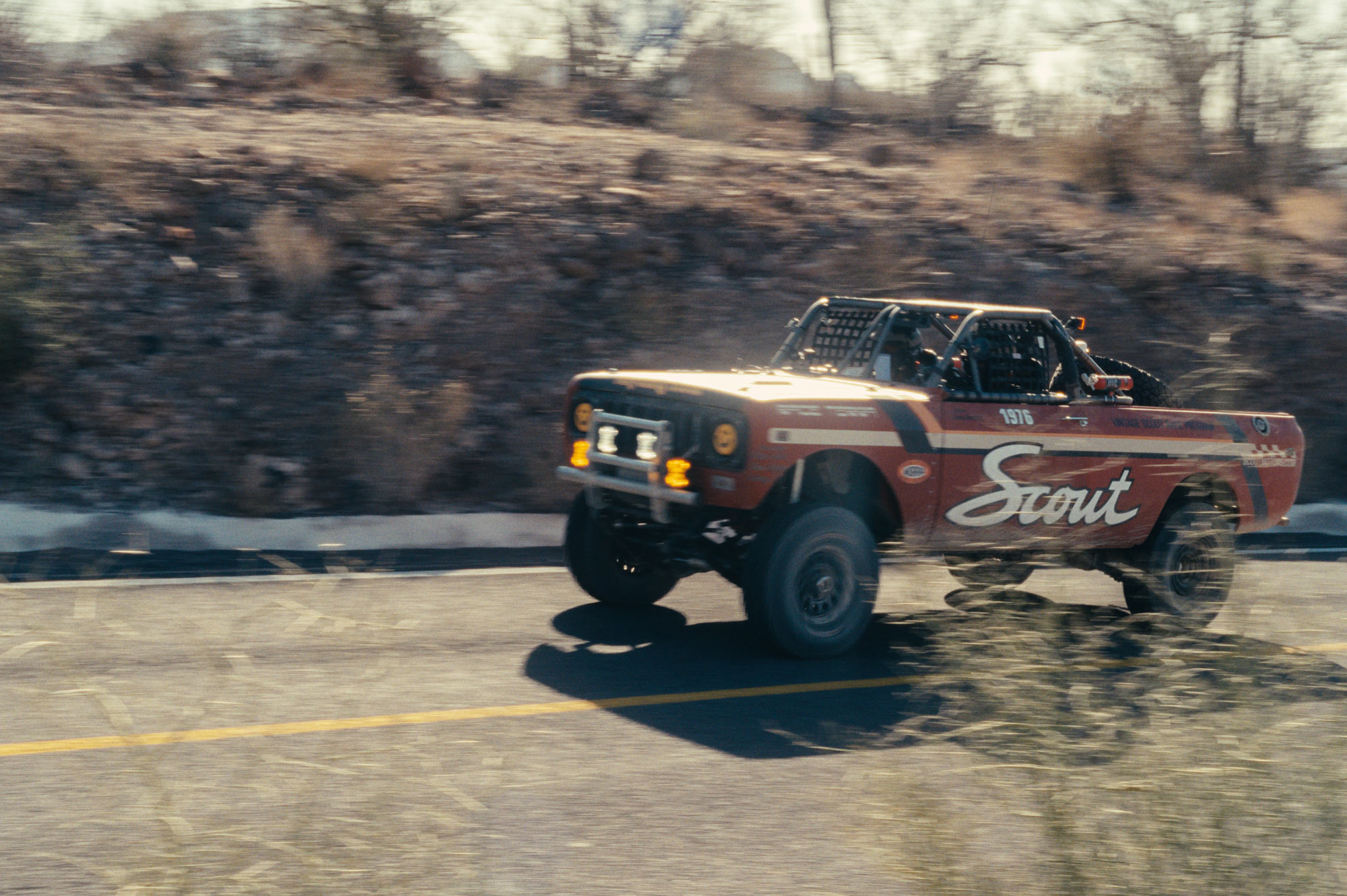

Scout Motors may build new trucks—but we wouldn’t be here without people like Sean. People who’ve lived with these vehicles since the beginning. People who care deeply about the brand’s history—and what it represents.
“I used to have one of those” is a phrase we hear often. And it’s more compliment than nostalgia. Sean’s work in the vintage Scout community now offers people the chance to have one again.
For Scout Motors, supporting the Vintage Scout Race Program just makes sense. It’s grassroots. It’s a little ragtag. And it’s inspiring. Scout vehicles have always been here—and so have the people who drive them. Or in this case, race them. We’re proud to continue that legacy.
By now, Sean and Owen have each had a coffee—while racing. There’s not much room in the truck for extras, but snacks and drinks pack easy. The chase crew tracks the Race Terra’s progress by GPS, sending out the occasional update. From the Pacific Coast, they pass through San Juanico and head toward La Purísima. They’ve seen every kind of terrain today—including silt—but they keep on trucking.
As the Race Terra nears the finish, the chase crew has just a couple of chances to intercept them for gas or repairs. Two support trucks wait roadside, gas cans ready, wrenches in hand, as the Scout enters its final section for the day. But the truck blows past us—Owen throws a thumbs-up through the safety net. They did the whole day on a single tank of gas, with about 1/8 left. Noted for tomorrow.
“Bienvenido a Loreto!” A hand-painted sign greets us as we roll into town. Loreto is one of the bigger cities we hit on the NORRA 1000. A little touristy, still picturesque, and straight out of another era. It was one of the first Spanish settlements on the Baja Peninsula—early colonial architecture still lines the streets near the oceanfront. The finish line is here too, right on the water. The Race Terra crosses the checkered flag—now surrounded by sailboats and seaside hotels.
When you run out of stickers, you start ripping patches off your race suit. At least that’s what Owen did. In true Baja form, fans crowd the drivers, asking questions, snapping photos of the Scout.
“I think the clutch slave is giving out.” Like clockwork, Sean starts his daily report. We don’t even need to ask anymore. “We navigated the silt well too.” Bad news, then good. But we’ve got a spare clutch slave—it just gets added to the cardboard list for tonight. “Maybe a new fan belt too.” He keeps naming off parts for Dan and Larry to check—but they already know, just by looking at the truck.
Tomorrow is set to be over 300 miles—our longest day yet. It’s been in the back of our minds all week.
Tomorrow, it’ll be right in front of us.
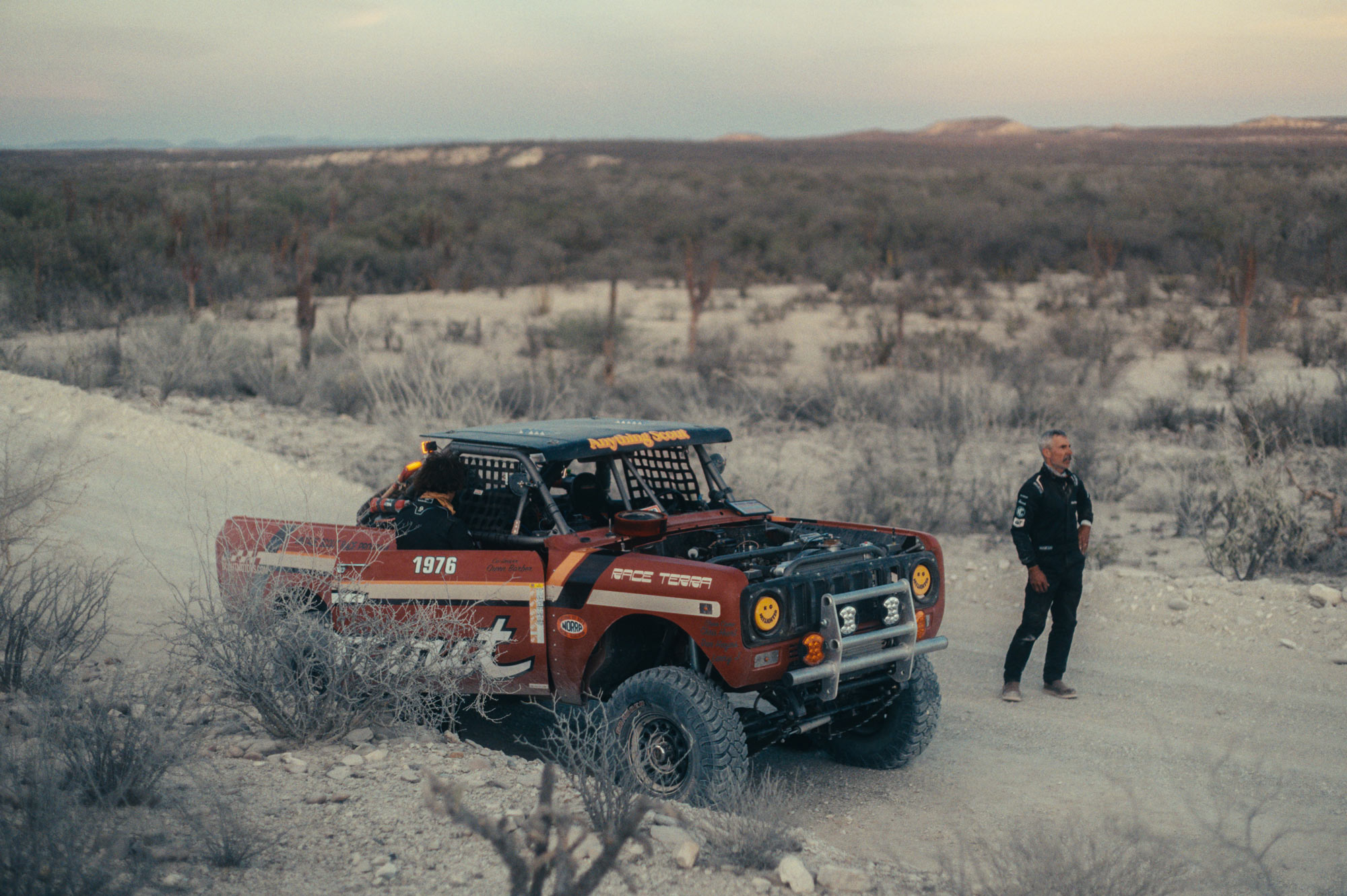

April 30, 2025
STAGE 5:
Loreto to La Paz
Miles: 336.9
t’s going to be a long day.” Every morning, Sean Barber delivers a sermon of sorts. And today, those are the first words out of his mouth. If desert racing were a religion, Baja would be the Mecca.
336.9 miles. It’s hard to put that into perspective—especially given Baja’s unruly terrain. It’s a long day on paper. It’s even harder to imagine how much time it will take to complete. For some frame of reference, the last stage tonight will close at 12 a.m. They’re giving racers every possible minute available to accomplish today’s course.
But first, coffee. Even in Baja, we have a morning routine. Today, we decide to walk to a local coffee shop and see the town. The last thing Owen asked before leaving Ventura was whether or not there was room in the chase truck for his skateboard. There was, so in it went. Now his morning routine includes pushing and carving around the old towns.
“Today’s going to be a challenge,” Sean says to the team, nine espressos—one in front of each of us. All the unknown variables for today just mean we’ll have to be prepared for anything and everything. Sean, Owen, and Chris Hunt review the maps and plan points for the race truck and support trucks to meet. “I’m thinking about those cliffs today…” another thought out loud about the terrain ahead from Sean. There’s probably a lot else on their minds, too.
10:01 a.m. is our start time this morning, earlier than previous days. Hopefully, we can use this extra hour to our advantage, as we’re imagining needing every second. We’re heading from Loreto to La Paz today. The starting line is beautiful this morning. The green flag waves, and we peel down the ocean avenue, flying by palm trees with the blue sky and turquoise ocean to our side.
We strategize a bit and decide to start with less than a full tank of gas. It’ll save us some weight and work in our favor against the elements. From Loreto, we head west, now turning our backs to the sea. Sean and Owen pick up the pace as they stare at the inland mountains head-on.
The Race Terra isn’t seen again until 1:19 p.m. The first section of the day is behind them. Like clockwork, Sean and Owen exit the truck. Dan and Larry go through the mid-race pit checks. “Worst silt yet,” Sean says, helmet still on, now standing beside the truck, in between handfuls of trail mix. “Oh man, we came around a blind corner and there were seven, maybe eight trucks stuck. It was hairy.”
You never know what’s waiting around the next turn. The digital road book that Owen uses to navigate does its best to call out any known hazards on the course. But by the time dozens of trucks have gone through, everything could be different. Ten gallons of race gas go in the Scout. Dan and Larry roll out from beneath the truck—everything looks good. “We’ve been doing a lot of rapid-deploy four-wheel drive, it’s working great.” Our repairs from previous days seem to be holding well, so off we go.
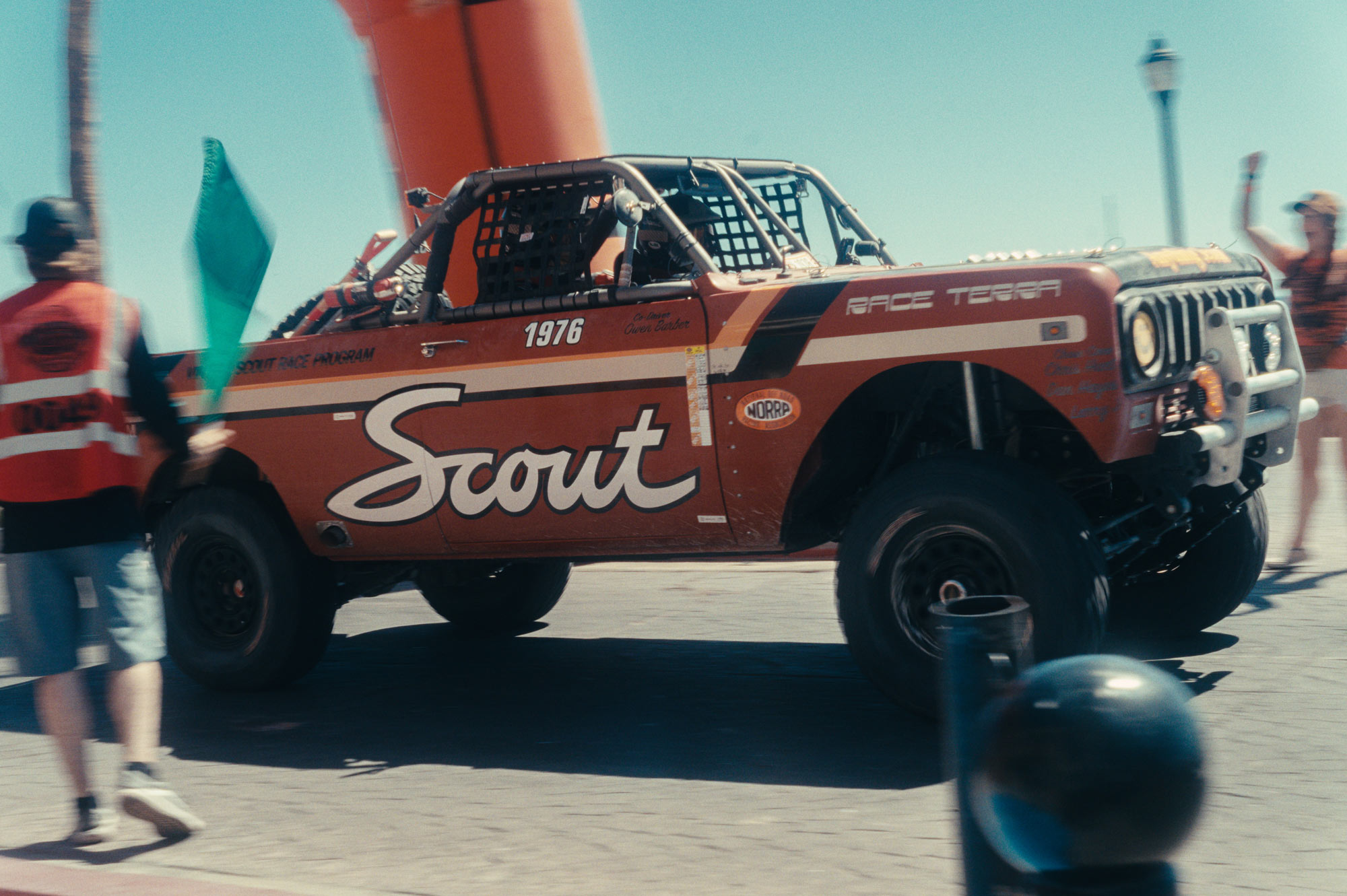

The Race Terra zig-zags further down the peninsula, and the chase trucks coast down the highway from Ciudad Constitución to Comondú. Another race report from Sean amidst a quick stop: “Pretty bumpy, we took a big hit on something. But Owen checked it out—everything looks and feels good. Man, we’ve still got that rocky hill climb ahead of us, huh? I don’t want to do that in the dark.”
It’s now 3:37 p.m. They still have well over 150 miles left to go for the day. Their pace isn’t ideal; however, there’s not much they can do about it. They’re fighting one of the toughest topographies in the world, and their weapon of choice is a 50-year-old truck. They’re going as fast as they’re comfortable with—not as fast as possible. Like Sean said a few days ago, “medium and steady.”
The support trucks are now stationed in Las Pocitas, following the Scout on GPS, waiting for it to arrive. It’s well past 5 p.m. when the GPS rings with the message: “Issues, troubleshooting, send both trucks and trailer.”
Instant heartache. Our stomachs are in our chests. We pack up the trucks and turn around, heading back toward their direction. We all remain silent. So many questions, but we don’t ask. We do what we’re told.
It’s late enough in the evening, and so few vehicles are still racing, that we’re able to drive our trucks onto the course for a recovery mission. Sean and Owen are about 15 miles ahead on this dirt road. We have to remember that the course is still hot, as we are soon met with two race trucks barreling toward us. The trail of dust in the distance is a good indication of what’s ahead, so we make sure to pull over and give way.
At sunset, the desert is a painting. The dust-filled sky glows purples, yellows, reds, and blues. Cacti are silhouetted against the evening sky for miles and miles. The chase trucks eventually spot the Race Terra on the horizon.
The mood is tense. Larry runs up as Sean and Owen run through everything they’ve troubleshot. It’s seemingly an electrical issue. Dan has a test light in one hand and a voltmeter in the other. The truck is cranking, but no spark. Sean replaced the coil on the trail, but to no avail. Dan gives us two options: “We can try and fix it here, or we can put it on the trailer and fix it at camp.” It’s nearly dark now, and the Race Terra is loaded up.
The first chase truck goes ahead, while the second slowly and carefully tows the Scout 15 miles back down the dirt road toward the main highway. The truck ahead makes its way into La Paz just before the auto parts store closes for the evening. We have a list of parts and the translation app open on our phone to communicate with the employees. We grab a new coil, among other things, and quickly head out of town to meet everyone back at camp.
It’s 10:30 p.m. when our work lights go up over the Race Terra. It’s late. We’re all exhausted. We have a list of action items. We’re on a mission, and there’s no time for anything else but to try and fix the truck. Tomorrow is the last day of the race.
Last year, on the last day of the race, we had the unimaginable happen. One small move sent Sean and Owen tumbling 300 feet down a canyon—just 30 miles short of the finish line. But we’re not even thinking about that now. We just need to fix the truck.
Dan, Larry, Sean, and Owen continue troubleshooting. A table is set up next to the Scout, covered in new and old parts, tools, and tacos. They try one thing, crank it—still no spark. They try another—same result. They start thinking backwards. Could it be two things at once? Was the original issue a red herring?
Sean soon realizes the coil he replaced on the trail is rated for the wrong ohms. Visually, it’s identical, but it’s designed for a V8. We’re running the 196ci 4-cylinder. The coil we picked up in town, however, has the correct ohms for a 4-cylinder. We swap that in and install a new old stock distributor cap. It’s period-correct for 1976 and just so happens to be an International Harvester OEM part. It needs to be shaved down a bit—it’s hitting our custom intake manifold. We make some clearance and squeeze it in.
At 11:45 p.m., the engine roars to life. Sean, mouth full of tacos, turns to the race team and says, “That’s good news, boys. I’m so happy.”
We all were.


May 1, 2025
STAGE 6:
La Paz to San Jose Del Cabo
Miles: 171.50
oday’s the day. Sean and Owen cheers their espresso to whatever is ahead. Owen carries around a pocket full of 4x6 prints—taken on multiple disposable cameras from last year's race. We just so happen to patronize a few of the same coffee shops and cafes, and folks remember us. We left an impression on Baja. Baja left an impression on us.
All nine of us fit inside this little cafe for our morning ritual.
It’s the last day of the race. On this day last year, Sean and Owen had a fateful moment that they were lucky to walk away from. But they wouldn’t accept that. Baja won last year. This year, they are here to win.
The caffeine starts hitting and doing its job. Sean and Owen’s minds are racing as fast as the truck is—but you wouldn’t be able to tell. They’re cool, calm, and collected. Classic.
“I think I’ve lost 5 lbs on this trip.” A great first line out of Sean this morning. He’s probably being serious, too. The Baja diet is what we call it. Hyper-focus, tense posture, and a little nutrition is what it takes. That, plus all the demands of wrestling a truck across the desert.
After coffee, Dan heads into town to the parts store to replenish our spares. Another coil just in case. Sean runs laps in the truck to make sure last night’s repairs hold tight. Everything checks out.
The tire pressure goes back up to 22 psi, and the Scout takes to the starting line. 11:12 a.m., and the green flag waves. 171.5 miles to San Jose del Cabo.
The chase trucks have a strategy of their own today. The silver F-250 takes the quickest way to the finish line to ensure we can catch the Scout as it rolls into town.
The gold F-250 takes a route that keeps them closer to the Race Terra. It carries the mechanics, all the tools and spares—and a trailer.
Cabo, here we come.
“Baja” simply translates to “bottom.” At the bottom of the bottom, the Gulf of California meets the Pacific Ocean. The thousand-mile-long desert that once separated these two oceans now fades into the sea. Soon, there’ll be no further place south to race toward.
Later in the afternoon, the gold F-250 intercepts the Race Terra just once. All it needs is gas, a drop to 17 psi in the tires, and a bunch of high fives. We’re further now than we were last year. All of the worries fade, and the stoke takes over. The truck disappears into a mirage once again.
The streets are alive in Cabo. It’s hot. It’s bright. There’s a hustle and bustle here. The town is dense. Alleyways cut through the city, each lined with palm trees and flowers.
As you make your way down the peninsula, you catch glimpses of the ocean. Point breaks filled with surfers, the teal water and white sands are hypnotizing. The streets are lined with spectators. Folks have set up chairs down the entire length of the finish line avenue.
This race has a history in every town it visits. It’s been happening for over 50 years—and hopefully continues for at least 50 more. Parents who bring their kids into town to see the race were once kids themselves, brought here by their parents decades ago.
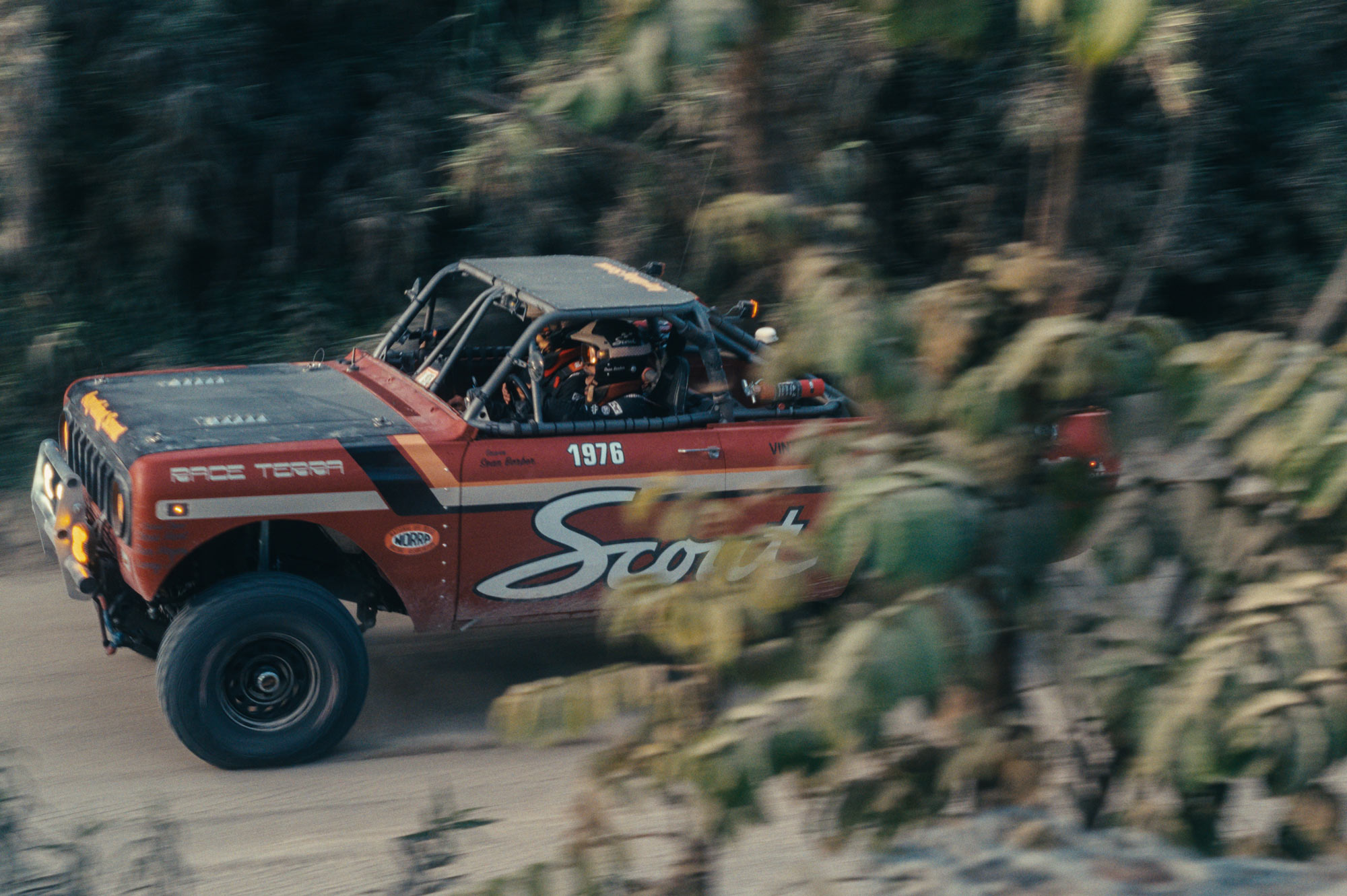

Sean and Owen enter their last off-road stage of the entire race. It’s golden hour now. Their pace has been modest today, but for a good reason. With every turn and new direction, they are one step closer to the finish line. Finishing in one piece with all four wheels still attached is the goal. If they can maintain their speed and focus, they’ll do just that.
Right before 5:45 p.m., the Race Terra roars into town and the checkered flag drops.
Helmets are off. Emotions are felt. Fists are bumped. Smiles all around. A triumphant return to Baja indeed.
The finish line is a car show and a block party combined. Our boys cruise in cool as ever, sweating more than ever. We came back here to do this one thing.
Like every time before, Dan and Larry get under the truck to look for any issues. But this time, it doesn’t matter. It’s just second nature. Sean and Owen do the same, going through the day’s events, recalling any issues with the truck—slowly fading out.
“And boys, we did it,” Sean fades back in. “We got first place!” Yup, first in the “Legends” class. Our truck maintained as much original and archaic technology as possible. They were doing it 50 years ago with the same machines—there’s no reason why we couldn’t do the same. The terrain hasn’t changed much either since then.
Sean is already thinking about the next race. He and Dan start discussing potential engine swaps and small upgrades. The race team strolls through town as the sun sets over the palm trees and far-off mountains in the distance.
We shake hands with those we spent the week racing against. There are apologies for passing, laughing about mishaps and repairs. Conquering Baja is one of the last few “tough things” left in the world. Those who have been here know. It’s a cool club to be in.
We load the Race Terra onto our trailer and head to camp for the night.
“That was fun,” Sean says. “Let’s go surfing tomorrow.”
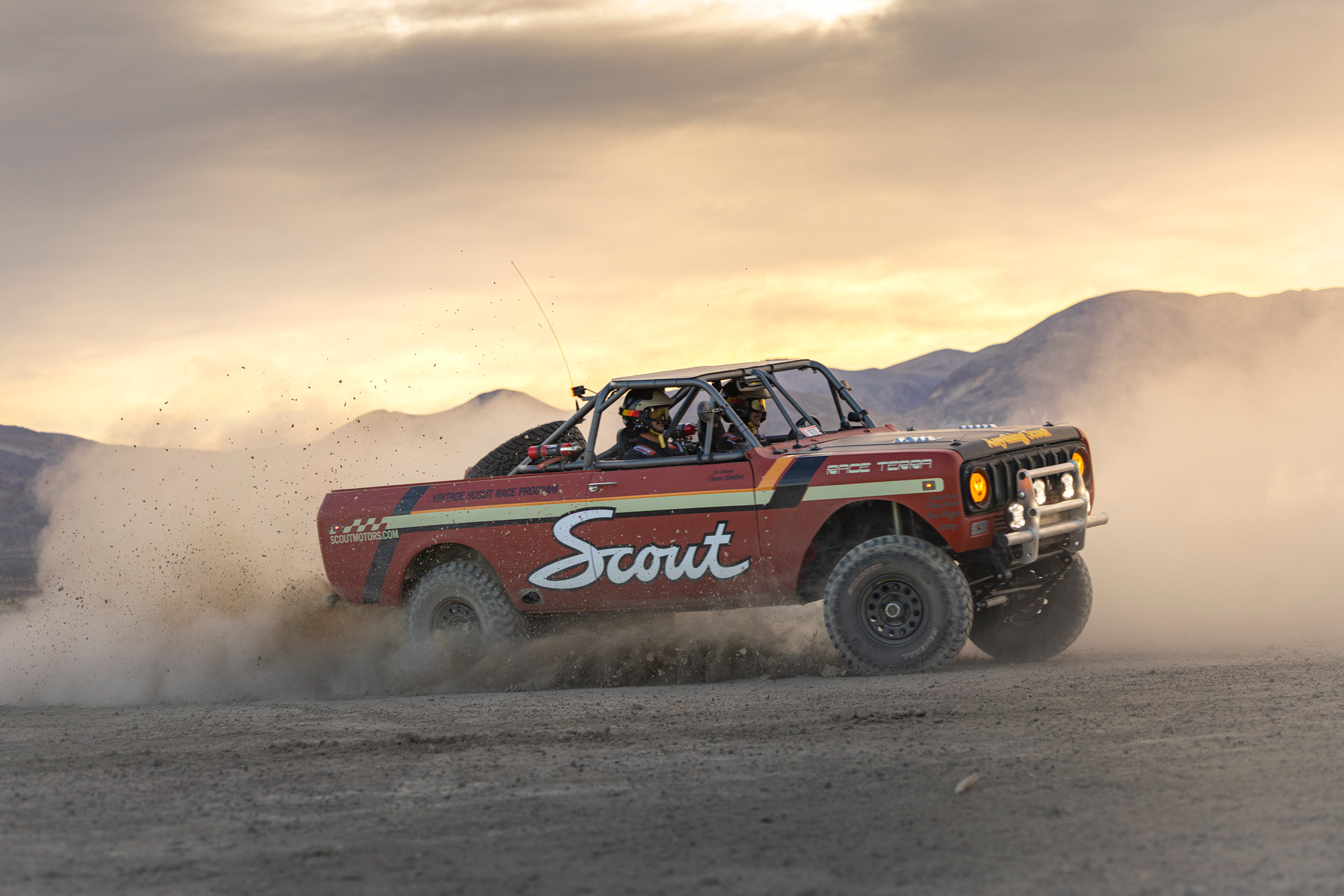

Back to Baja: Sean Barber Returns to the Mexican 1000®
The last time the Anything Scout founder raced Baja, disaster struck. Will fortune favor him this year?
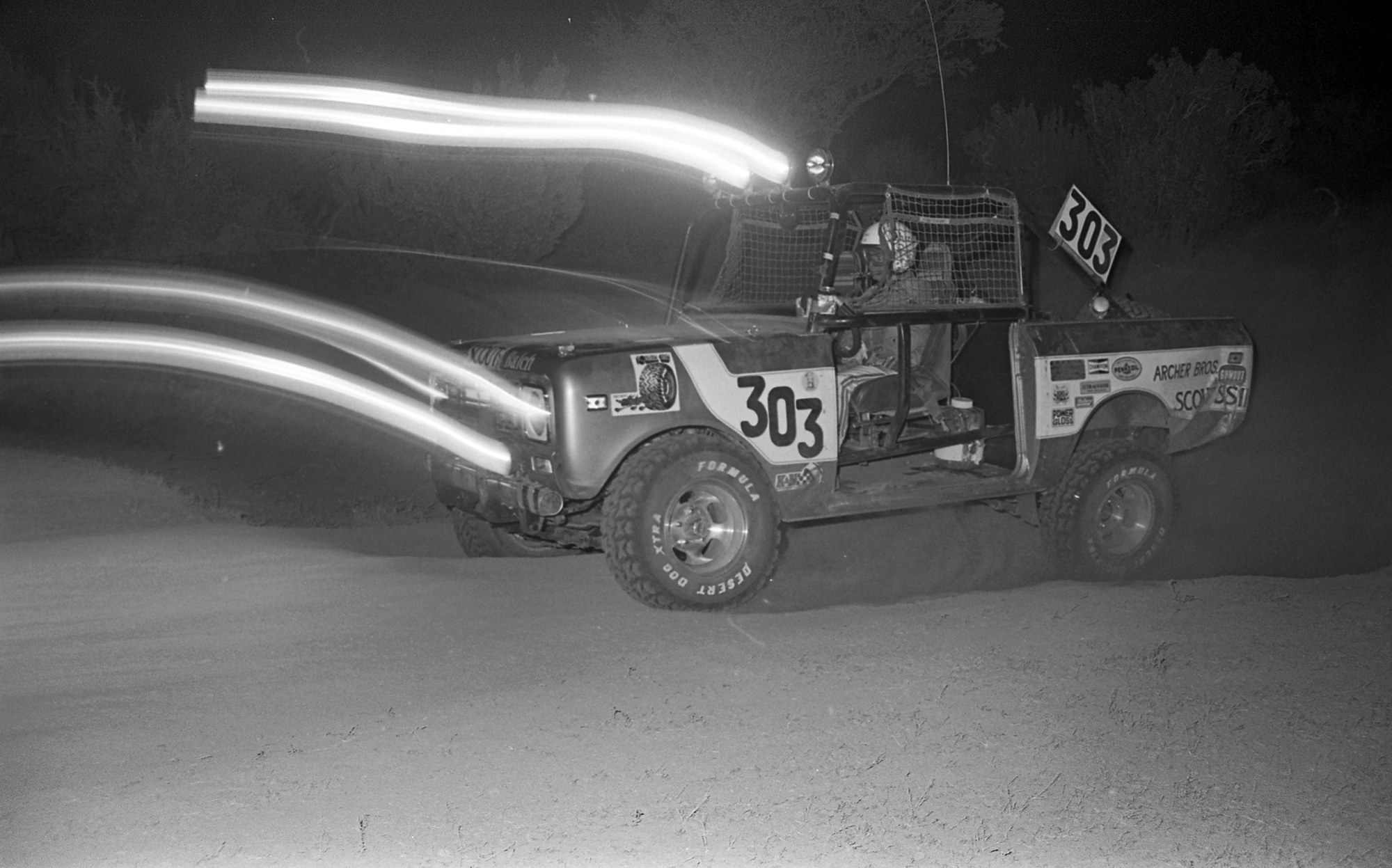

Scout Racing: When Super Scout™ Racers Conquered the Desert
The Scout SUV, already an off-road icon, was well positioned to capitalize on the trend when a privately-owned 800A marked the brand’s desert-racing debut in the 1969 Baja 1000®.
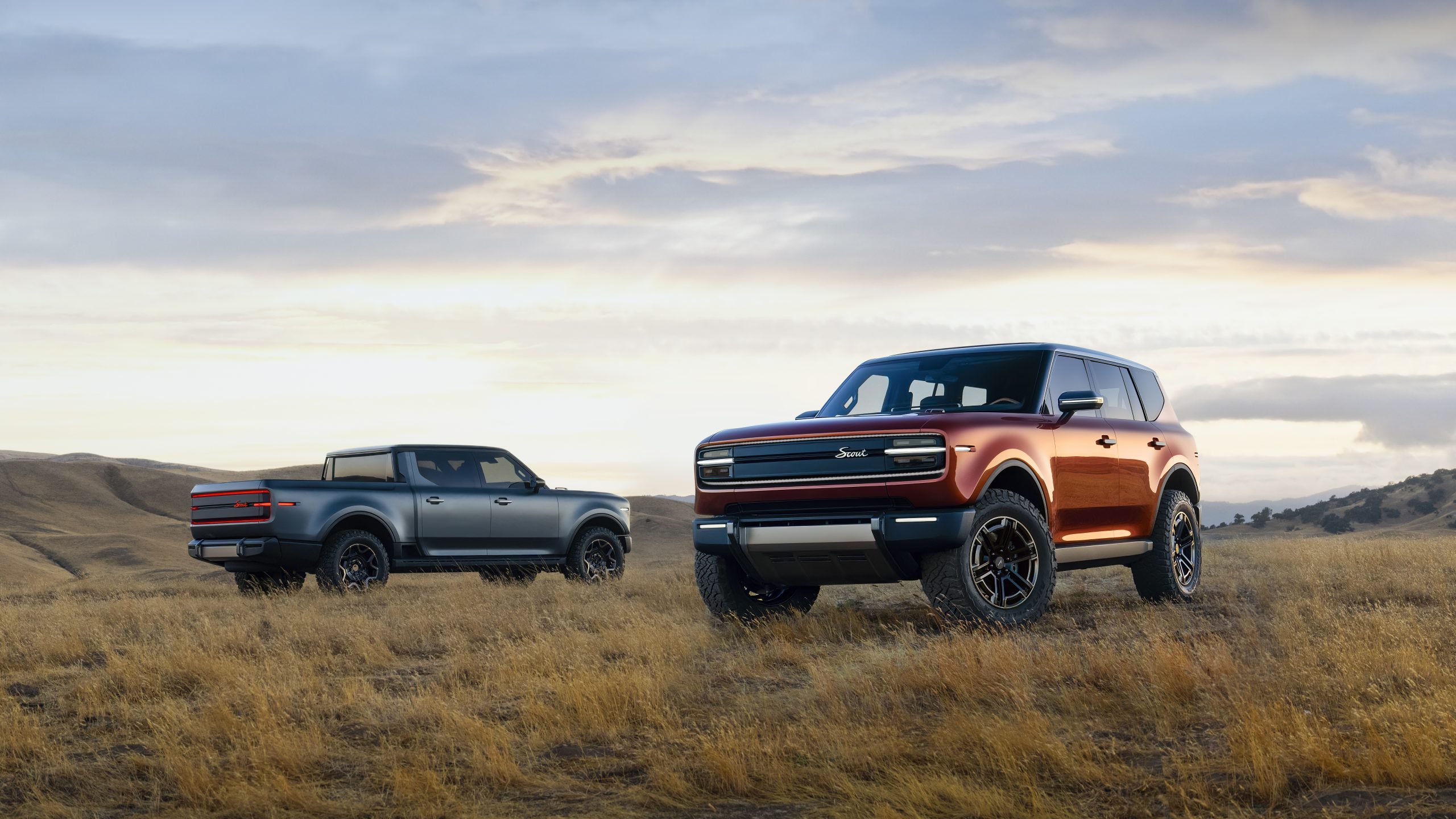

The Scout® Traveler™ SUV and Scout® Terra™ Truck
Scout Motors has unveiled two heritage-inspired, 8-day-a-week concept vehicles.
Follow along as the adventure unfolds at the Mexican 1000.
Scout Motors on Instagram /NORRA Mexican 1000 rally | Follow the Vintage Scout Racing Program on Instagram.
Scout, Terra, and Traveler are registered trademarks and trademarks of Scout Motors Inc. All the other trademarks are the property of their respective owners.

